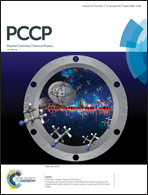Interactions of methanol, ethanol, and 1-propanol with polar and nonpolar species in water at cryogenic temperatures
Abstract
Methanol is known as a strong inhibitor of hydrate formation, but clathrate hydrates of ethanol and 1-propanol can be formed in the presence of help gases. To elucidate the hydrophilic and hydrophobic effects of alcohols, their interactions with simple solute species are investigated in glassy, liquid, and crystalline water using temperature-programmed desorption and time-of-flight secondary ion mass spectrometry. Nonpolar solute species embedded underneath amorphous solid water films are released during crystallization, but they tend to withstand water crystallization under the coexistence of methanol additives. The CO2 additives are released after crystallization along with methanol desorption. These results suggest strongly that nonpolar species that are hydrated (i.e., caged) associatively with methanol can withstand water crystallization. In contrast, ethanol and 1-propanol additives weakly affect the dehydration of nonpolar species during water crystallization, suggesting that the former tend to be caged separately from the latter. The hydrophilic vs. hydrophobic behavior of alcohols, which differs according to the aliphatic group length, also manifests itself in the different abilities of surface segregation of alcohols and their effects on the water crystallization kinetics.



 Please wait while we load your content...
Please wait while we load your content...